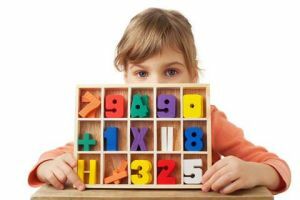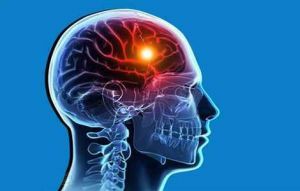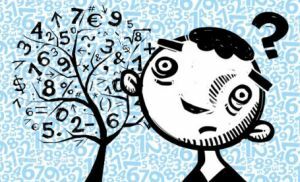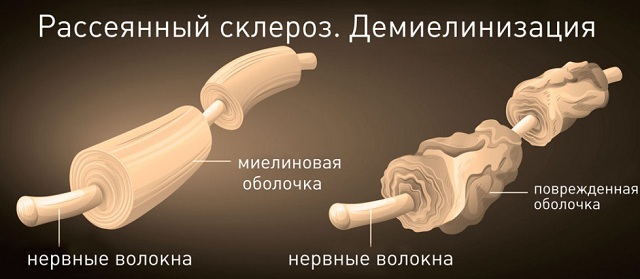 Akalkuliya is a neuropsychic syndrome, characterized by a loss of ability to arithmetic operations and the perception of numbers. It develops in the defeat of the dominant hemisphere: in right-handed people in the left hemisphere, in right-handed left-handed people.
Akalkuliya is a neuropsychic syndrome, characterized by a loss of ability to arithmetic operations and the perception of numbers. It develops in the defeat of the dominant hemisphere: in right-handed people in the left hemisphere, in right-handed left-handed people.
Acalculia is an acquired disease, and occurs against the background of lesions of brain areas or neuropsychiatric diseases. It occurs against the background of disturbances in the temporal, parietal and occipital areas of the cerebral cortex, which in turn arises due to trauma, neuroinfections, neoplasms, etc.
Also often acalculia develops against the background of the underlying neurological or mental illness. Thus, acalculia is often combined with the following diseases: optical agnosia, alexia, dyslexia, acoustic-mnestic aphasia, attention deficit, sensory aphasia, amnesia, dementia, stroke.
Content
- Causes of
- varieties and forms
- disease differs from dyscalculia
- Symptoms violation
- diagnostics,
- Treatment and correction
- Primary violation
- Therapy secondary form
- Implications and limitations
Causes of
dyscalculia is caused by a lesion of the parietal, occipital, temporaland prefrontal cortex. The reasons for such brain damage can be different:
- a significant number of neurological disorders in the perinatal period
- hereditary factor;

- organic brain damage;
- of neuroinfections;
- neoplasms in the brain;
- various intoxication;
- dysmetabolic abnormalities;
- cerebral infectious disease;
- negative social environment;
- cerebrovascular diseases;
- craniocerebral trauma.
Varieties and forms of the disease
Development of acalculia occurs in disorders of various cognitive systems. Depending on what cognitive function is affected, these types of disease are distinguished:
- Verbal - deviations in the verbal designation of the concepts of mathematics. The patient can successfully perform mathematical
 operations, but can not verbally denote the name of numbers, symbols, unable to designate the number of objects.
operations, but can not verbally denote the name of numbers, symbols, unable to designate the number of objects. - Apraxic - the person is not able to count items. The patient can not make a score of objects, and highlight their quantitative characteristics.
- Dyslexic - lack of ability to read mathematical symbols, express quantitative terms.
- Graphical - the inability to write mathematical symbols and signs, and also correctly represent geometric shapes.
- Operational - loss of ability to perform mathematical operations.
Also the cases of acalculia can be subdivided on the basis of primary and secondary.
Primary( specific) - caused by lesions of the cortical areas, the following types are distinguished:
- Frontal - is caused by impaired functioning of the frontal lobe of the brain, which is responsible for the control, regulation of all mental functions of a person. Ability to account is violated due to deviations in the organization of conscious activity.
- Dark( parieto-occipital) - occurs when the parieto-occipital lesions of the brain are affected. The patient violated the concept of "number", understanding the essence of counting operations, the perception of spatial coordinates.
Secondary( nonspecific) - occurs due to neuropsychiatric disease, these types are distinguished:
- Optical - occurs in the pathology of the lobes of the brain responsible for the visual analyzer. With optical acalculation
 , visual perception of numbers and mathematical signs is disrupted. The patient is not able to distinguish similar arithmetic symbols, to recognize Roman numerals.
, visual perception of numbers and mathematical signs is disrupted. The patient is not able to distinguish similar arithmetic symbols, to recognize Roman numerals. - Sensory - develops when lesions of brain regions involved in acoustic perception of speech. It manifests itself in difficulties with oral counting and carrying out counting operations by ear.
- Acoustic mnemonic - also associated with acoustic perception of speech. The difference lies in the fact that the patient has impaired hereditary memory and reduced the volume of auditory perception.
Difference from dyskulkulii
Akalkuliya and dyscalculia are similar concepts, but there is a difference between them. It consists in the fact that dyscalculia is a consequence of congenital disorders of the development of the brain and with it mathematical knowledge is not fully assimilated. Akalkulia is an acquired condition, and it arises because of neurological injuries and disorders acquired in the course of life.
Symptoms of violation of
The symptoms of acalculia vary depending on the form of the disease.
In the primary form of the disorder, the patient has such symptoms:
- difficulties in understanding the difference between externally similar numbers( eg, 147 and 174);
- inability to accept the category of numerical digits;
- difficulties in performing simple arithmetic operations;
- violation of the understanding of the concept of "number";
- lack of ability to compare numeric values;
- the perception of spatial coordinates is violated;
- difficulties in evaluating numbers that have a digit "zero" in their composition;
- is difficult to subtract, and addition is relatively easy.
The secondary form of acalculia is manifested by such symptoms: 
- there is no visual perception of numbers, and ignorance of their names;
- disturbed the perception of numbers and mathematical operations by ear;
- problems with understanding mathematical operations, their planning and control over implementation.
Inspection and Diagnosis
The doctor can be diagnosed as a defectologist, psychologist, psychiatrist, specialist in neuropsychology.
The account disorder rarely acts as the only cognitive impairment, and is often accompanied by other pathologies. Acalculia may not be detected during the initial examination and diagnosis, due to more intense manifestations of other disorders.
Diagnosis can be made after arithmetic tests and their analysis. Excessively low results indicate a pathology. It is also necessary to use such diagnostic measures as tests for revealing pathologies of speech, writing, reading, orientation in space, praxis.
Treatment and correction of
In the treatment of acalculia, the main treatment measures should be aimed at eliminating the causes of the disease.
The choice of the correction program depends on the form of the disease, and, accordingly, the reasons for its occurrence. Complex therapy is carried out by such specialists: clinical psychologist, defectologist, psychiatrist, neuropsychology specialist.
Primary disorder
 In the primary form of acalculia, the main task is to restore the patient's perception of numbers, their discharges. Special methods are used, the main principle of which is working with the patient's visual memory.
In the primary form of acalculia, the main task is to restore the patient's perception of numbers, their discharges. Special methods are used, the main principle of which is working with the patient's visual memory.
Cards with numbers, objects and their quantity are applied. It is preferable to use bright and diverse colors, as this promotes better perception and memorization. When working with children, it is desirable to use game forms.
Working with numbers is the need to expand any of them into variations. Auxiliary tool can be sticks. For example, the patient is called the number 7 and gives the task to break it into possible components.
The patient performs this task, laying out the rods in such combinations: 3 + 4, 2 + 5, 1 + 6.All actions are recorded in the therapy diary. If the result is progressing, an oral comment on the mathematical actions is added - all operations are accompanied by pronouncing. This contributes to the development of the ability to generate an account in the mind.
In case of violation of the perception of the names of numbers and their categories, the work of specialists consists in pronouncing numbers from 1 to 100 together with the patient, and parallel explanations regarding units, tens. One of the exercises is to write numbers in numbers under their letter designations. For example, next to the words two hundred and forty-one write 241.
After 3 sessions, visual forms and figurative materials should be supplemented with oral forms of work, articulating the arithmetic operations.
Therapy of the secondary form of
Treatment of the secondary form of acalculia is selected depending on the area of the affected cerebral cortex:
- When the occipital part of the bark of is damaged, the treatment is aimed at restoring the correct writing of numbers, and their visual
 perception. This is the aim of such methods: exercises with the motor way of numbers, subject count, various manipulations with tasks and numbers, sounding numbers, while presenting them in the mind. The best results are achieved with a satisfactory level of development of visual memory, ability to imagine, auditory perception.
perception. This is the aim of such methods: exercises with the motor way of numbers, subject count, various manipulations with tasks and numbers, sounding numbers, while presenting them in the mind. The best results are achieved with a satisfactory level of development of visual memory, ability to imagine, auditory perception. - In patients with temporal lesions of the cerebral cortex , auditory perception of numbers is impaired in patients. With this disorder, there is no need for specialized therapy.
- For violations in the prefrontal departments of the bark therapeutic measures are aimed at teaching the understanding of numbers, simple arithmetic operations, gradually moving to more complex operations.
Consequences and limitations
Acalculium can cause various complications. These negative consequences include agrammatism( difficulty in composing and accepting sentences), paraphasia( substitution of sounds, misuse of sounds), speech embolus( obsessive repetition of words or phrases).
The consequences of acalculia are also attributed to a decrease in the social adaptation of an individual due to a combination of the disease with other cognitive impairments. As a consequence, the quality of life of the patient decreases.
With the development of the disease in children, this causes problems in learning, social adaptation in school, worsens communication skills and can adversely affect the child's further cognitive development. Children may develop low self-esteem and depression.



